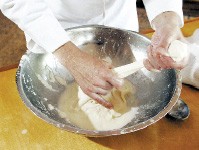In a few days, Brown Burch will be taking a vacation from his 60-hour-a-week sous-chef position at the Inn at Hunt Phelan. During that vacation, he’ll be working 10 to 12 hours a day — unpaid — doing whatever is asked of him, and when his time is up after a couple of weeks, he’ll be sad to go.
Burch, 25, is headed to the acclaimed Chicago restaurant Alinea for a two-week stage — a French term for an internship in the culinary arts. Last year, Ruth Reichl of Gourmet declared Alinea the “Best Restaurant in America” in the magazine’s twice-per-decade list of America’s Top 50 Restaurants.
Working like a dog without pay might seem like a crazy idea, but for the passionate aspiring cook who wants to learn from the best, it’s often the only way.
“In France, we say if you have a flamme secrète — a secret flame, an unyielding passion for something such as cooking and food — you will do whatever it takes to become the best,” says Jose Gutierrez, the owner/chef of Encore, who spent many years as a stagiaire (an intern) in some of the top restaurants in France.
Gutierrez explains that in France, after graduating from cooking school, it could easily take 10 years of stage-ing and apprenticing before a cook moves up to the next rank. “This time is not about making money. It’s about learning your craft and concentrating on your craft and nothing else,” Gutierrez says.
Europe is the ultimate stage destination for many American cooks. Labor laws are such that in many countries, foreigners must forgo pay to work in trendsetting restaurants.
On egullet.com, the Web site of the Society for Culinary Arts and Letters, young cooks from all over the world exchange their stage experience, and most of them agree on one thing: If you think it’s tough in the kitchen you’re working in now, wait until you work in Europe. One stagiaire recalls his first days at Oustau de Baumanière, a Relais & Chateaux hotel/restaurant in Provence, where he spent several days in “ravioli limbo,” making close to 1,000 chicken-, leek-, and truffle-filled ravioli.
“As stagiaire, you’re on the bottom of the food chain,” says Gutierrez. “But you don’t complain. You do what the chef tells you to do, and if he wants you to wash his car during your break, you wash his car during your break.” Gutierrez calls it an investment in your future, a life lesson.
And the young stagiaire who spent days making ravioli? He had never seen that many truffles in his life, and it was an absolute delight to him to have his blistered hands fragrant with their precious aroma. The point is that you can only endure long hours and hard labor if passion is strong, as it is for Burch.
Although Burch has always had an interest in food (at his mother’s house, you can find pictures of him as a 4-year-old slurping oysters in New Orleans) and has been working in restaurants since he was a senior in high school, his determination and love for cooking developed slowly, growing as he’s gotten more experience.
He’s had short stages at Joël and ONE.Midtown Kitchen in Atlanta, Frank Stitt’s restaurant in Birmingham, as well as numerous other well-known restaurants. All he’s done for the past year is work and save money. While his other twentysomething peers party, he cooks. When he’s not cooking, he reads about cooking and food.
It might seem that if you offer your skills for free, it shouldn’t be hard to find a place that will gladly take you in. That’s true, but for young cooks interested in doing a stage at a first-rate restaurant, the competition can be fierce. And once that person has his or her foot in the door, they’ll have to give their everything and set themselves apart to be recognized in the kitchens of lauded places such as Alinea or the French Laundry in Napa Valley, which can choose from the best.
“The task is really how to distinguish yourself from the other 15 stagiaires, so the chef will even pay attention to you,” says Gutierrez. Outperforming everybody else and, according to Gutierrez, stealing the chef’s recipes (to a French chef, a sign of ultimate determination) is a start.
Contrary to European stages, which are at least two months long and provide the young native cooks with food, lodging, and a meager allowance, most restaurants in the United States let culinary apprentices come in and observe for a couple of days and generally don’t provide housing.
As for Burch, he’s ready for blistered hands. He’s saved enough money to work without pay for a while (as long as he can sleep on a friend’s couch), and he’s determined to learn from the best and bring back his knowledge and honed skills to Memphis when the time is right.
 Courtesy of Reinaldo Alfonso
Courtesy of Reinaldo Alfonso 